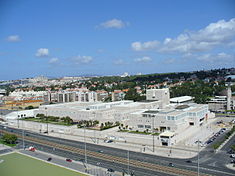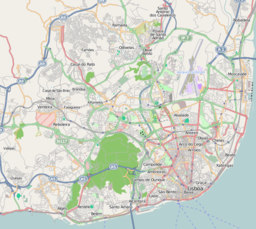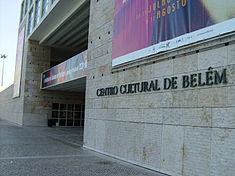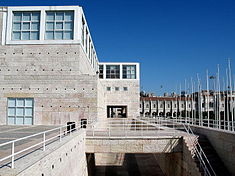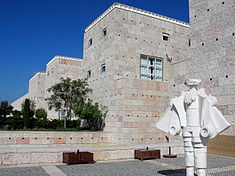- Belém Cultural Center
-
Belém Cultural Center (Centro Cultural de Belém) Cultural center (Centro Cultural) Country  Portugal
PortugalRegion Lisbon Sub-region Grande Lisboa District Lisbon Municipality Lisbon Location Santa Maria de Belém - elevation 293 m (961 ft) - coordinates 38°41′43.47″N 9°12′31.18″W / 38.6954083°N 9.2086611°W Area 140,000 m2 (1,506,948 sq ft) Architects Vittorio Gregotti, Manuel Salgado Style Modern Material Concrete Origin January 1988 - Initiated July 1989 - Inaugurated September 1993 Owner Centro Cultural de Belém (CCB) Foundation For public Public Visitation Closed (25 December) Management Centro Cultural de Belém (CCB) Foundation Weekdays 8:00 a.m. to 8:00 p.m. Weekends 10:00 a.m. to 7:00 p.m. Wikimedia Commons: Belém Cultural Centre Website: http://www.ccb.pt/sites/ccb/en-EN/Pages/default.aspx The Belém Cultural Centre (Portuguese: Centro Cultural de Belém (CCB)), located in the civil parish of Santa Maria de Belém (in the municipality of Lisbon), is the largest building with cultural facilities in Portugal. The CCB's 140,000 m² spaces was initially built to accommodate the European Presidency, but adapted to provide spaces for conferences, exhibitions and artistic venues (such as opera, ballet and symphony concerts), in addition to political and research congresses, high security meeting halls, and a 7,000 m² exhibition area.
Contents
History
The decision to construct the Cultural Centre of Belém occurred in January 1988, as part of the Portuguese government's need to construct a building to welcome and accommodate the people involved in Portugal's European Union Presidency (in 1992).[1][2] The facility would also serve as a core facility for cultural and leisure activities after its term, and serve as a venue for conferences and exhibitions.
An international architectural competition was held and six proposals were invited to submit a preliminary project, out of the 57 submissions.[2] The final proposal, submitted by the architectural consortium of Vittorio Gregotti (Italy) and Atelier Risco at the time led by Manuel Salgado (Portugal), was designed to include five modules: a Conference Centre, a Performing Arts Centre, a Exhibition Centre, Hotel and complementary equipment zone, but only the Conference Centre, the Performing Arts Centre and the Exhibition Centre were initially constructed.[1][2][3]
Starting in July 1989, the buildings along the waterfront were demolished and the many of the infrastructures were reestablished. By January 1992, modules 1, 2 and 3 were completed and ready to accommodate the institutions, administration, communication centre and security of the European Union Presidency. A year later the Conference Centre and small auditorium (March) and later the Exhibition Centre were opened to the public. By fall of the same year (September), the main auditorium was inaugurated.
Architecture
The building is located in Santa Maria de Belém, near the riverfront west of Lisbon, between the dual Avenida da Índia-Avenida de Brasilia motorway and Rua Bartolomeu Dias.[3] Apart from fronting the Praça do Iméprio (English: Imperial Square), it juxtopositions the Jerónimos Monastery, and is surrounded by many historical buildings, such as the Palace and the Tower of Belém, the Museum of Archaeology, the Planetarium, the Monument to the Discoveries.[3]
The Belém Cultural Centre has 140,000 m² of construction area and was prepared in a very short period (1989–1992). The client of the project was the Portuguese State through the Secretaria de Estado da Cultura (State Agency for Culture). Completed in 1992, it occupies a total of 100,000 m² and is the work of architects Vittorio Gregotti and Manuel Salgado; the interior was planned by Daciano Costa.
Its designed, aligned with the Jerónimos’ Monastery, intentionally fronts the Império Square, and consists of structural blocks with courtyards and "patio-squares" that interconnect the three principal structures.[4] Each centre is separated by transversal “streets”, that link the building's interiors which are extensions of the city of Lisbon's historical urban structure.[4] The centrality of the main building extends the urban fabric to the interior creating a public space.[4] This architectural style can best be interpreted by Santana and Matos (2010) who refer to as the “patios-squares” versus the “narrow streets” a conflicting dynamic structure.[4]
With highly sophisticated equipment and a wide variety of installed services, it has several areas with different roles:
- The Conference Centre, provides a close link with the most varied business and professional sectors; conceived in order to support conferences and meetings, as well as the CCB operational services, stores, a restaurant, two bars, parking areas and the Jacques Delors European Information Centre;[1]
- The Performing Arts Centre, the core of the sites cultural and artistic activities, it includes two auditoriums (the larger holding 1429 seats and the smaller with 348 seats), rehearsal hall with 72 seats, in order to support film, opera, ballet, theatre and music events;[1]
- The Exhibition Centre, which includes four galleries for exhibitions of modern art, architecture, design and photography, in addition to coffee and concessionary shops; it also, since June 2007, has been the venue for the Foundation of Modern and Contemporary Art (the Berardo Museum Collection);[1]
- The Educational Area provides a close link between the Foundation and schools of various levels as well as other institutions;
- The Formation Area is a service of the Belém Cultural Centre Foundation; courses, seminars and Conferences are directed towards teaching and learning, as well as the acquisition of further knowledge, skills and specialisation in the different areas of the arts, and culture.
The Belém Cultural Centre won the International Stone Architecture Award at the Verona Fair in 1993.
It has already hosted important events like the summit meeting of the Heads of State of the Organization for Security and Co-operation in Europe (OSCE).
References
- Notes
- Sources
- Ferreira, E.; Cabello, J. (2008), Lisbon: A Complete Visitor's Guide to the City, Florence, Italy: Casa Editrice Bonechi, ISBN 978-88-476-2319-4
- Santana, Cátia; Matos, Madalena Cunha (12–15 July 2010), "Buildings and Urban Form: Investigating Buildings with a Positive Urban Transformation Dimension", Urban Transformation: Controversies, Contrasts and Challenges, 14th IPHS Conference, Istanbul, Turkey: Research Centre for Architecture, Urban Planning and Design (CIAUD)-Faculdade de Arquitectura – Universidade Técnica de Lisboa, pp. 4–6, http://www.iphs2010.com/abs/ID358.pdf, retrieved 27 June 2011
See also
Categories:- Culture in Lisbon
- Buildings and structures in Lisbon
Wikimedia Foundation. 2010.

